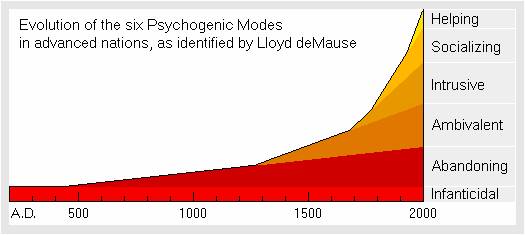A psychogenic mode in Psychohistory is a type of mentality that results from, and is associated with, a given type of childrearing style.
The major psychogenic modes first identified by Lloyd deMause are:
| Mode | Childrearing Characteristics | Historical Manifestations |
|---|---|---|
| Infanticidal | Early infanticidal childrearing: High infanticide rates, incest, body mutilation, child rape, tortures, and emotional abandonment by parents. |
Child sacrifice and infanticide, intolerance of child's anger, hardening, ghosts and magic, child sale, child sodomy. |
| Late infanticidal childrearing: Similar to early infanticidal childrearing, but the young child is not overtly rejected by the mother, and the father begins to be more involved with the instruction of older children. |
||
| Abandoning | Early Christians considered a child as having a soul at birth, although posessed by evil tendencies. Routine infanticide was replaced by joining in the group fantasy of the sacrifice of Christ, who was sent by his father to be killed for the sins of others. Routine pederasty of boys continued in monastries and elsewhere, and the rape of girls was commonplace. | Longer swaddling, fosterage, outside wetnursing, oblation of children to monasteries & nunneries, and apprenticeship. |
| Ambivalent | Parents began to sustain amibivalence -- both love and hate -- towards children. The twelfth century saw the first child instruction manuals and rudimentary child protection laws, although most mothers still emotionally rejected their children. Children were often treated as erotic objects by adults. | Enemas, early beating, shorter swaddling, mourning for deceased children, a precursor to empathy. |
| Intrusive | During the sixteenth century, particularly in England, parents shifted from trying to stop childrens' growth to trying to control them and make them obedient. Parents were prepared to give them attention as long as they controlled their minds, their insides, their anger and the lives they led. | Early toilet training, repression of child's sexuality, end of swaddling and wetnursing, empathy now possible, rise of pediatrics. |
| Socializing | Beginning in the eighteenth century, mothers began to actually enjoy child care, and fathers began to participate in younger childrens' development. The aim remained instilling parental goals rather than encouraging individuation. Psychological manipulation and spanking were used to make children obedient. The Socializing Mode remains the most popular model of parenting in the Americas and Western Europe to the present day. | Use of guilt, "mental discipline", humiliation, rise of compulsory schooling, delegation of parental unconscious wishes. |
| Helping | Beginning in the mid-twentieth century, some parents adopted the role of helping children reach their own goals in life, rather than "socialize" them into fulfilling parental wishes. Less psychological manipulation, more unconditional love. Children raised in this way are far more empathic towards others in society than earlier generations. | Children's rights movement, deschooling and free schooling, natural childbirth, Taking Children Seriously. |
The chart below shows the dates at which these modes evolved in the most advanced nations. The timeline doesn't apply to hunter-gatherer societies, where there has always been a wide variation in childrearing practices. It is notable that the arrival of the Ambivalent mode of child-rearing preceded the start of the Renaissance (mid 1300's) by only one or two generations, and the arrival of the Socializing mode coincided with the Age of Enlightenment, which began in the late 1700's.
See also[]
Assessment |
Biopsychology |
Comparative |
Cognitive |
Developmental |
Language |
Individual differences |
Personality |
Philosophy |
Social |
Methods |
Statistics |
Clinical |
Educational |
Industrial |
Professional items |
World psychology |
Social psychology: Altruism · Attribution · Attitudes · Conformity · Discrimination · Groups · Interpersonal relations · Obedience · Prejudice · Norms · Perception · Index · Outline
External links[]
| This page uses Creative Commons Licensed content from Wikipedia (view authors). |
